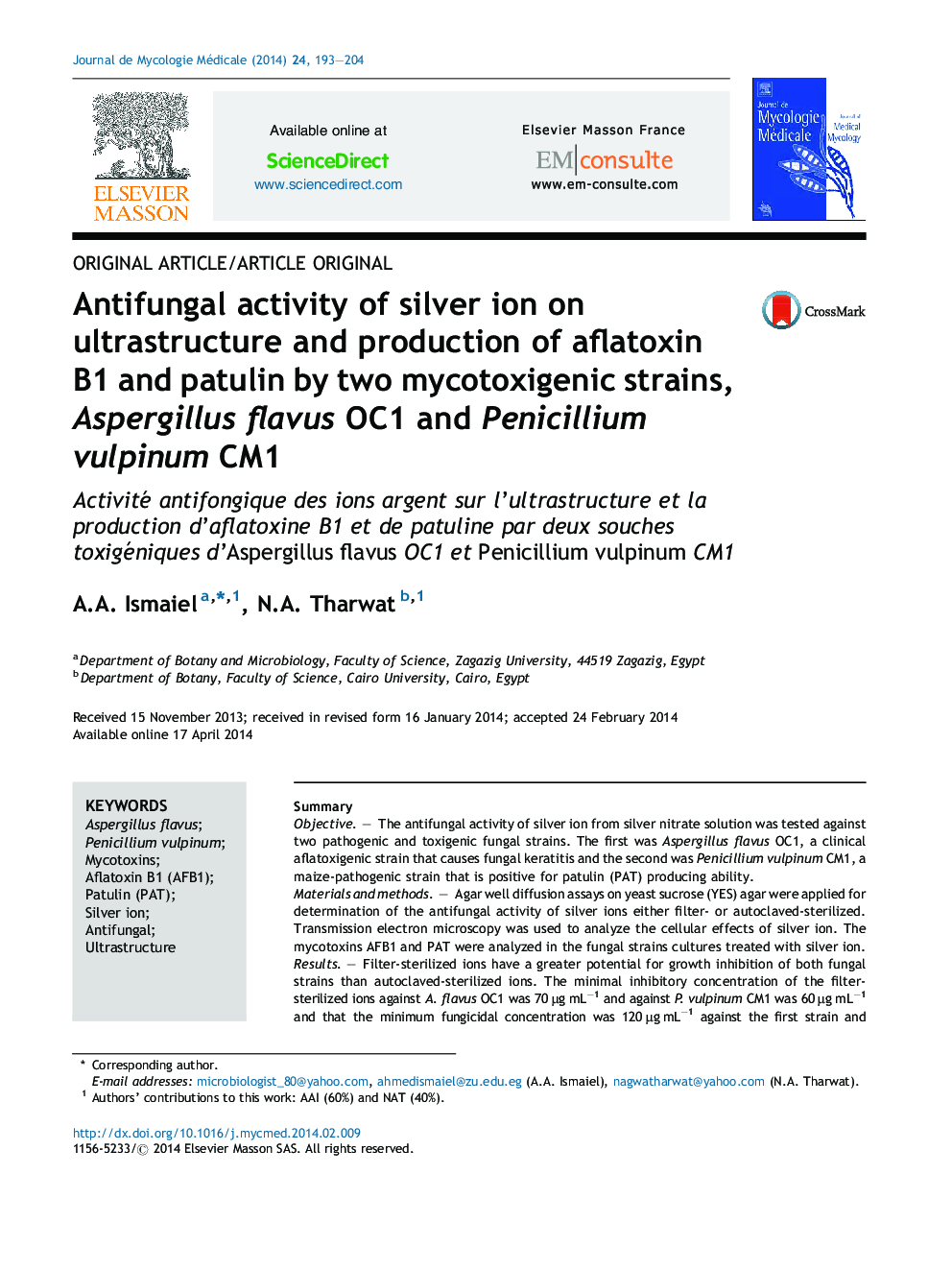| کد مقاله | کد نشریه | سال انتشار | مقاله انگلیسی | نسخه تمام متن |
|---|---|---|---|---|
| 3219371 | 1204446 | 2014 | 12 صفحه PDF | دانلود رایگان |

SummaryObjectiveThe antifungal activity of silver ion from silver nitrate solution was tested against two pathogenic and toxigenic fungal strains. The first was Aspergillus flavus OC1, a clinical aflatoxigenic strain that causes fungal keratitis and the second was Penicillium vulpinum CM1, a maize-pathogenic strain that is positive for patulin (PAT) producing ability.Materials and methodsAgar well diffusion assays on yeast sucrose (YES) agar were applied for determination of the antifungal activity of silver ions either filter- or autoclaved-sterilized. Transmission electron microscopy was used to analyze the cellular effects of silver ion. The mycotoxins AFB1 and PAT were analyzed in the fungal strains cultures treated with silver ion.ResultsFilter-sterilized ions have a greater potential for growth inhibition of both fungal strains than autoclaved-sterilized ions. The minimal inhibitory concentration of the filter-sterilized ions against A. flavus OC1 was 70 μg mL−1 and against P. vulpinum CM1 was 60 μg mL−1 and that the minimum fungicidal concentration was 120 μg mL−1 against the first strain and 80 μg mL−1 against the second strain. Hyphal cells treated with silver ion showed considerable changes in the nature of cell membranes and cytoplasmic organelles. Silver applied to YES broth inhibited mycelial growth and AFB1 and PAT formation of both strains. Growth and mycotoxin production appeared to be correlated processes.ConclusionThese findings indicate the future possibility to use silver ion as substitute for synthetic fungicides to control the growth of pathogenic fungi and their mycotoxin production.
RésuméObjectifL’activité antifongique ions argent de la solution de nitrate d’argent a été testée contre deux souches fongiques pathogènes et toxigènes. Le premier était Aspergillus flavus OC1, une souche clinique aflatoxigène qui provoque une kératite fongique et la seconde était Penicillium vulpinum CM1, une souche pathogène pour le maïs, qui est positive pour la capacité de production de patuline (PAT).Matériels et méthodesDes méthodes par diffusion à partir de puits en yeast sucrose (YES) agar ont été appliquées pour la détermination de l’activité antifongique des ions argent, stérilisés par filtration ou par autoclavage. La microscopie électronique à transmission a été utilisée pour analyser les effets cellulaires des ions argent. Les mycotoxines AFB1 et PAT ont été analysées dans les cultures traitées avec l’ion argent.RésultatsLes ions stérilisés par filtration ont un potentiel plus grand d’inhibition de la croissance des deux souches fongiques que les ions stérilisés en autoclave. La concentration minimale inhibitrice (CMI) des ions filtrés contre A. flavus OC1 était de 70 μg mL−1et contre P. vulpinum de 60 μg mL−1. La concentration fongicide minimale a été de 120 μg mL−1 contre la première souche et 80 μg mL−1contre la seconde souche. Les cellules des hyphes traitées avec l’ion argent ont montré des changements considérables dans la nature des membranes cellulaires et des organites cytoplasmiques. L’argent appliqué au YES en milieu liquide a inhibé la croissance du mycélium et la production de AFB1 et de PAT pour les deux souches. La croissance et la production de mycotoxines semblaient être des processus corrélés.ConclusionCes résultats indiquent la possibilité future d’utiliser des ions argent comme substitut aux fongicides synthétiques pour contrôler la croissance des champignons pathogènes et leur production de mycotoxine.
Journal: Journal de Mycologie Médicale / Journal of Medical Mycology - Volume 24, Issue 3, September 2014, Pages 193–204